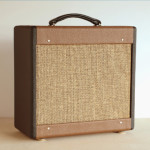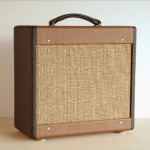Home › Forums › Design and Building › 2 Stroke Amplifier Design and Building › Impedance switch wiring
- This topic has 8 replies, 2 voices, and was last updated January 4, 2015 at 8:09 pm by
 Robin.
Robin.
-
AuthorPosts
-
December 27, 2014 at 3:14 am #5085
s3mamill
ParticipantAnother question on a different topic:
The impedance switch is arranged a little differently than what I see in the book (instead of poles on the left, middle and right there are 2 poles on one side and 1 on the other).
Any suggestions about which pole is the one that goes to the speaker jacks?
December 30, 2014 at 2:46 am #6030 RobinParticipant
RobinParticipantI’ve used that switch a lot too. Depending on what speaker loads you are using, connect the correct color secondary leads from the OT to each side of the switch and then connect the remaining switch lug to the speaker. You can check it with your meter. I think the kit suggested wiring when using a 4 & 8 ohm speaker load and the Hammond 125ESE OT is to use the Yellow and White secondary leads.
To learn about how the OT works with the primary input impedance (from the power tube) and how it relates to the correct secondary impedance. DH’s book covers it as does Merlin Blencowe’s great website: http://www.valvewizard.co.uk/se.html
Using the correct speaker load is important but not exact. Fender has gotten away with 100% mismatched impedance (when using the ext speaker out) from the beginning. Some designs even use impedance mismatch intentionally. Using the correct load is easier on the OT and give the most output.
December 30, 2014 at 10:00 pm #6031s3mamill
ParticipantThanks for your reply Robin. DH says that most switches like this are wired backwards (i.e. the yellow wire is on the right pole, but its engaged when the switch bat is to the left). Since you have used this switch before, can you tell me if its the same in this case. I wouldn’t know how to tell on my own if the impedance is correct (I don’t have a multimeter).
December 30, 2014 at 11:52 pm #6032 RobinParticipant
RobinParticipantDH’s explanation holds for the Carling H 494 (SPDT) switch. BUT, you really need a multimeter. To confirm continuity between connections, check grounds, and measure voltages, you need a meter. Included in the minimum tools you need to build an amp are a multimeter and a circuit limiter (light bulb limiter). Google “light bulb limiter circuit” or use this link:
http://www.thegearpage.net/board/showthread.php?t=608547Without a current limiter, you run the risk of frying the PT (and/or other components) when you fire up your amp for the first time if there is a dead short somewhere and you need the meter to confirm the grounds are correct. Speaking from experience, I would advise you to get a meter and build a circuit limiter before continuing with your amp construction.
December 31, 2014 at 12:48 am #6033s3mamill
ParticipantRobin: The dim bulb tester seems pretty straightforward. I think you’re right, this is a cheap way to avoid replacing expensive components.
Can you say more (or link to relevant information) about testing grounds and voltages with a meter? I’ve fussed around with a meter checking speaker impedances, but how would one go about using it in an amp?
I realize this can be dangerous. I think what I’ll do is start with a dim bulb test and if there is an issue, bring it to my tech to troubleshoot.
December 31, 2014 at 2:06 am #6034 RobinParticipant
RobinParticipantUse the meter to check continuity, checking to see that the solder joints are conductive (not cold), confirming that the connecting from point A to point B really goes where it’s suppose go. Also, checking that the grounded connects are good to ground and that there are no unintended grounds.
Also, checking to see that component values are correct and that the published voltages around the circuit are correct. Most of the time, new builders with an amp that does not work or preforms poorly think that it must be a bad component or a mistake in the schematic or layout. But, it almost always turns out to be a bad ground, misplaced or missing lead or a weak or bad solder joint.
In terms of safety, you can do all the continuity checking with the amp off and unplugged, so as long as you discharge the caps, you’re totally safe. Some tests, like checking voltages and biasing (not required in the Two Stroke), require that the amp be on so you need to be careful about where you touch. Clipping one meter lead to the chassis (chassis ground) and using one hand only to touch the other meter probe to various points in the circuit will keep you from sending lethal voltages through you. It helps to know where the B+ voltages are in the amp. There is no virtue in holding both meter probes and moving around the circuit with the amp on, if you slip, you get shocked. I use a test lead with alligator clips connected to the meter probe to check areas where I don’t want to risk holding a probe.
January 3, 2015 at 10:20 pm #6035s3mamill
ParticipantCan anyone recommend an cheapish (<50$) multimeter on amazon? Looks like some of the ones I looked at don't have leads compatible with alligator clips.
January 4, 2015 at 2:30 pm #6036 RobinParticipant
RobinParticipantThe Digitek DT 2844R auto-ranging DMM for $40.00 on Amazon looks like it would do the job. The Lead clips are listed at the bottom of the page. It’s not a Fluke and with meters, u usually get what you pay for but it has the features you need.
January 4, 2015 at 8:09 pm #6037 RobinParticipant
RobinParticipantThis link might be helpful: http://ampgarage.com/forum/viewtopic.php?t=26744
or this one: http://www.testequipmentdepot.com/amprobe/multimeters/Digital.htm
Also, BK & Extech meters review very well. I like an auto-ranging meter with 1000VAC capability. -
AuthorPosts
- You must be logged in to reply to this topic.
